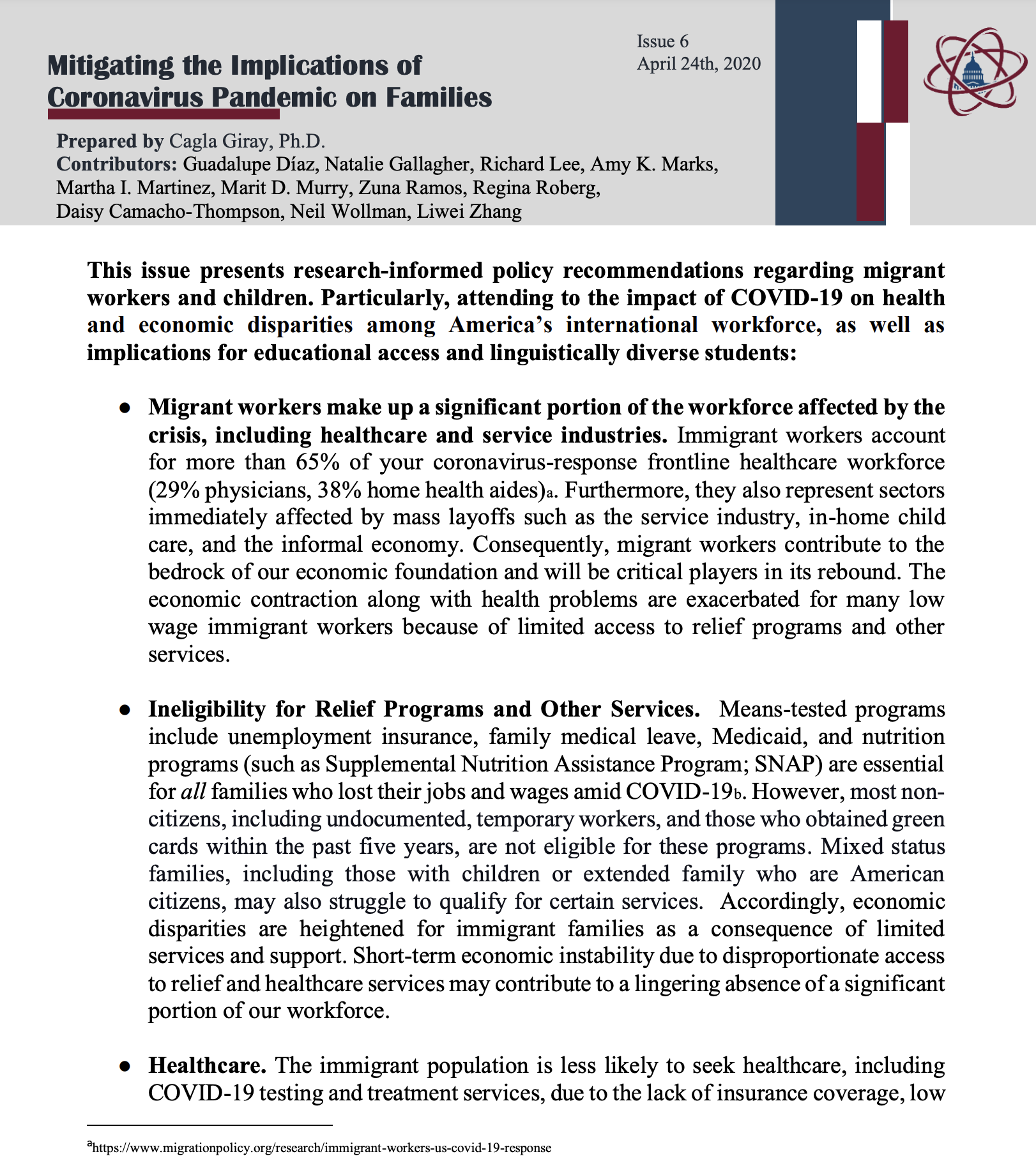
This issue presents research-informed policy recommendations regarding migrant workers and children. Particularly, attending to the impact of COVID-19 on health and economic disparities among America’s international workforce, as well as implications for educational access and linguistically diverse students:
- Migrant workers make up a significant portion of the workforce affected by the crisis, including healthcare and service industries. Immigrant workers account for more than 65% of your coronavirus-response frontline healthcare workforce (29% physicians, 38% home health aides) [i]. Furthermore, they also represent sectors immediately affected by mass layoffs such as the service industry, in-home child care, and the informal economy. Consequently, migrant workers contribute to the bedrock of our economic foundation and will be critical players in its rebound. The economic contraction along with health problems are exacerbated for many low wage immigrant workers because of limited access to relief programs and other services.
- Ineligibility for Relief Programs and Other Services. Means-tested programs include unemployment insurance, family medical leave, Medicaid, and nutrition programs (such as Supplemental Nutrition Assistance Program; SNAP) are essential for all families who lost their jobs and wages amid COVID-19 [ii]. However, most non-citizens, including undocumented, temporary workers, and those who obtained green cards within the past five years, are not eligible for these programs. Mixed status families, including those with children or extended family who are American citizens, may also struggle to qualify for certain services. Accordingly, economic disparities are heightened for immigrant families as a consequence of limited services and support. Short-term economic instability due to disproportionate access to relief and healthcare services may contribute to a lingering absence of a significant portion of our workforce.
- Healthcare. The immigrant population is less likely to seek healthcare, including COVID-19 testing and treatment services, due to the lack of insurance coverage, low income, immigrant status, limited language proficiency, and cultural mismatch. Moreover, there is also confusion on Medicaid’s eligibility requirements for COVID-19 testing [iii]. This increases the risk of infection and transmission among immigrant communities. Policymakers, therefore, may consider developing remotely-accessible, culturally-competent, and language-specific strategies in partnership with local organizations to increase access to healthcare and public health services.
- Education. It is extremely important to monitor and address the ways the COVID-19 pandemic is affecting educational access and progress for linguistically diverse students as schools implement distance and digital learning. Over 30% of children aged 0-17 live in a household where a language other than English is spoken. Approximately 10% of K-12 public school students are officially classified as English Learners. English Learners (ELs) are students in K-12 who are learning English in school, and their rights to English language development and to meaningful access to education are protected by federal and state laws.
- Their younger counterparts (commonly referred to as Dual language learners or DLLs) in the Early Childhood Education (ECE) system make up 23% of the children enrolled in ECE. Although DLLs do not share the same federal and state protections as ELs, many will become ELs when they enter kindergarten.
- It behooves us to consider the educational delivery provided to linguistically diverse children from the earliest years to promote the strongest long-term social and academic outcomes, including biliteracy (National Academies of Science, Education, and Medicine, 2017). Until more research is available on distance learning and linguistically diverse students, we can at least provide guidance on how to adapt research-based classroom practices for ELs and DLLs to distance learning.
- Since English language proficiency assessments used in EL classification and reclassification are non-operational through the end of the school year (or longer), states and districts may want to encourage select staff to use this time for professional development. Specifically, this time could be used to enhance the reliability decision-making regarding EL proficiency status. This may include training on family stressors that influence language development.
- More info in our Covid-19: Linguistically Diverse Students: Issues, Implications & Policy Recommendations fact sheet.
- Discrimination based on race and ethnicity. Recent data suggest that discrimination toward communities of color, in particular Asian immigrant communities, is deepened by the COVID-19 pandemic. Asian children and adolescents face higher rates of harassment, violence [iv] and bullying added to social isolation, all of which endanger their health and well-being. Policymakers could utilize social media and other public communication platforms to disperse misperceptions and present model inclusive behavior, acknowledging that COVID-19 is a global health crisis.
- Detention Centers are at high risk of virus infection, transmission and mortality. Detained immigrants and the staff at detention facilities have high risk of getting infected due to difficulty of following social distancing and hygiene measures. Clearly communicating a broader and more detailed announcement about how to modify specific ICE and Customs and Border Protection (CBP) immigration enforcement actions could alleviate fear and confusion among those who are undocumented. Community-based alternatives and selective release of individuals with low-risk of transmission (including unaccompanied minors) from detention could prevent COVID-19 infection, transmission, and death. COVID-19 is challenging us to innovate and leverage modern technologies in a variety of ways that help us adapt to the crisis; the spirit of innovation could carry over into the way policymakers modernize immigrant detention practices, leveraging technologies for monitoring undocumented individuals in community-based settings.
Additional Resources
- The Younique Foundation
- Prevention: Defend Innocence
- Healthcare for migrant children: What level of health care should detained children receive?
- Child Trends health and equity/education: School-based health centers can deliver care to vulnerable populations during the COVID-19 pandemic
- The Covid Tracking Project
- The What Works Clearinghouse at the US Department of Education’s Institute of Education Sciences announced first-ever cooperative rapid evidence synthesis to quickly gather and publicly share high-quality information about what works in distance education in response to COVID-19-prompted school closures.
- A Break from COVID-19: “The Office” star John Krasinski hosts a virtual senior prom
End Notes / References
[i] https://www.migrationpolicy.org/research/immigrant-workers-us-covid-19-response
[ii] Bernstein, H., McTarnaghan, S., & Gonzalez, D. (2019). Safety Net Access in the Context of the Public Charge Rule. Urban Institute. Retrieved from https://www.immigrationresearch.org/system/files/safety_net_access_in_the_context_of_the_public_charge_rule_1.pdf
[iii] National Immigration Law Center. (2020). Update on Access to Health Care for Immigrants and Their Families. Retrieved from https://www.nilc.org/issues/health-care/update-on-access-to-health-care-for-immigrants-and-their-families/
[iv] Asian Pacific Policy & Planning Council. (2020). Stop AAPI Hate Report. Retrieved from http://www.asianpacificpolicyandplanningcouncil.org/stop-aapi-hate/
The Research-to-Policy Collaboration (RPC) works to bring together research professionals and public officials to support evidence-based policy. Please visit their website to learn more.
Key Information
RPC Website
Research-to-Policy Collaboration
More RPC Resources
RPC Resources
Publication DateApril 24, 2020
Topic Area(s)Community-Specific, Health
Resource TypeWritten Briefs
Share This Page
This issue presents research-informed policy recommendations regarding migrant workers and children. Particularly, attending to the impact of COVID-19 on health and economic disparities among America’s international workforce, as well as implications for educational access and linguistically diverse students:
- Migrant workers make up a significant portion of the workforce affected by the crisis, including healthcare and service industries. Immigrant workers account for more than 65% of your coronavirus-response frontline healthcare workforce (29% physicians, 38% home health aides) [i]. Furthermore, they also represent sectors immediately affected by mass layoffs such as the service industry, in-home child care, and the informal economy. Consequently, migrant workers contribute to the bedrock of our economic foundation and will be critical players in its rebound. The economic contraction along with health problems are exacerbated for many low wage immigrant workers because of limited access to relief programs and other services.
- Ineligibility for Relief Programs and Other Services. Means-tested programs include unemployment insurance, family medical leave, Medicaid, and nutrition programs (such as Supplemental Nutrition Assistance Program; SNAP) are essential for all families who lost their jobs and wages amid COVID-19 [ii]. However, most non-citizens, including undocumented, temporary workers, and those who obtained green cards within the past five years, are not eligible for these programs. Mixed status families, including those with children or extended family who are American citizens, may also struggle to qualify for certain services. Accordingly, economic disparities are heightened for immigrant families as a consequence of limited services and support. Short-term economic instability due to disproportionate access to relief and healthcare services may contribute to a lingering absence of a significant portion of our workforce.
- Healthcare. The immigrant population is less likely to seek healthcare, including COVID-19 testing and treatment services, due to the lack of insurance coverage, low income, immigrant status, limited language proficiency, and cultural mismatch. Moreover, there is also confusion on Medicaid’s eligibility requirements for COVID-19 testing [iii]. This increases the risk of infection and transmission among immigrant communities. Policymakers, therefore, may consider developing remotely-accessible, culturally-competent, and language-specific strategies in partnership with local organizations to increase access to healthcare and public health services.
- Education. It is extremely important to monitor and address the ways the COVID-19 pandemic is affecting educational access and progress for linguistically diverse students as schools implement distance and digital learning. Over 30% of children aged 0-17 live in a household where a language other than English is spoken. Approximately 10% of K-12 public school students are officially classified as English Learners. English Learners (ELs) are students in K-12 who are learning English in school, and their rights to English language development and to meaningful access to education are protected by federal and state laws.
- Their younger counterparts (commonly referred to as Dual language learners or DLLs) in the Early Childhood Education (ECE) system make up 23% of the children enrolled in ECE. Although DLLs do not share the same federal and state protections as ELs, many will become ELs when they enter kindergarten.
- It behooves us to consider the educational delivery provided to linguistically diverse children from the earliest years to promote the strongest long-term social and academic outcomes, including biliteracy (National Academies of Science, Education, and Medicine, 2017). Until more research is available on distance learning and linguistically diverse students, we can at least provide guidance on how to adapt research-based classroom practices for ELs and DLLs to distance learning.
- Since English language proficiency assessments used in EL classification and reclassification are non-operational through the end of the school year (or longer), states and districts may want to encourage select staff to use this time for professional development. Specifically, this time could be used to enhance the reliability decision-making regarding EL proficiency status. This may include training on family stressors that influence language development.
- More info in our Covid-19: Linguistically Diverse Students: Issues, Implications & Policy Recommendations fact sheet.
- Discrimination based on race and ethnicity. Recent data suggest that discrimination toward communities of color, in particular Asian immigrant communities, is deepened by the COVID-19 pandemic. Asian children and adolescents face higher rates of harassment, violence [iv] and bullying added to social isolation, all of which endanger their health and well-being. Policymakers could utilize social media and other public communication platforms to disperse misperceptions and present model inclusive behavior, acknowledging that COVID-19 is a global health crisis.
- Detention Centers are at high risk of virus infection, transmission and mortality. Detained immigrants and the staff at detention facilities have high risk of getting infected due to difficulty of following social distancing and hygiene measures. Clearly communicating a broader and more detailed announcement about how to modify specific ICE and Customs and Border Protection (CBP) immigration enforcement actions could alleviate fear and confusion among those who are undocumented. Community-based alternatives and selective release of individuals with low-risk of transmission (including unaccompanied minors) from detention could prevent COVID-19 infection, transmission, and death. COVID-19 is challenging us to innovate and leverage modern technologies in a variety of ways that help us adapt to the crisis; the spirit of innovation could carry over into the way policymakers modernize immigrant detention practices, leveraging technologies for monitoring undocumented individuals in community-based settings.
Additional Resources
- The Younique Foundation
- Prevention: Defend Innocence
- Healthcare for migrant children: What level of health care should detained children receive?
- Child Trends health and equity/education: School-based health centers can deliver care to vulnerable populations during the COVID-19 pandemic
- The Covid Tracking Project
- The What Works Clearinghouse at the US Department of Education’s Institute of Education Sciences announced first-ever cooperative rapid evidence synthesis to quickly gather and publicly share high-quality information about what works in distance education in response to COVID-19-prompted school closures.
- A Break from COVID-19: “The Office” star John Krasinski hosts a virtual senior prom
End Notes / References
[i] https://www.migrationpolicy.org/research/immigrant-workers-us-covid-19-response
[ii] Bernstein, H., McTarnaghan, S., & Gonzalez, D. (2019). Safety Net Access in the Context of the Public Charge Rule. Urban Institute. Retrieved from https://www.immigrationresearch.org/system/files/safety_net_access_in_the_context_of_the_public_charge_rule_1.pdf
[iii] National Immigration Law Center. (2020). Update on Access to Health Care for Immigrants and Their Families. Retrieved from https://www.nilc.org/issues/health-care/update-on-access-to-health-care-for-immigrants-and-their-families/
[iv] Asian Pacific Policy & Planning Council. (2020). Stop AAPI Hate Report. Retrieved from http://www.asianpacificpolicyandplanningcouncil.org/stop-aapi-hate/
The Research-to-Policy Collaboration (RPC) works to bring together research professionals and public officials to support evidence-based policy. Please visit their website to learn more.

Key Information
RPC Website
Research-to-Policy Collaboration
More RPC Resources
RPC Resources
Publication DateApril 24, 2020
Topic Area(s)Community-Specific, Health
Resource TypeWritten Briefs
Share This Page
LET’S STAY IN TOUCH
Join the Evidence-to-Impact Mailing List
Keep up to date with the latest resources, events, and news from the EIC.




